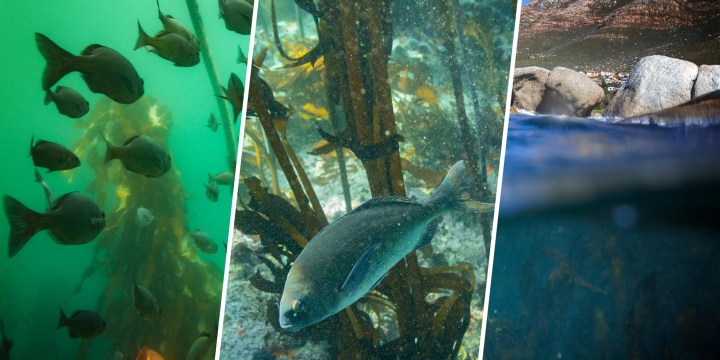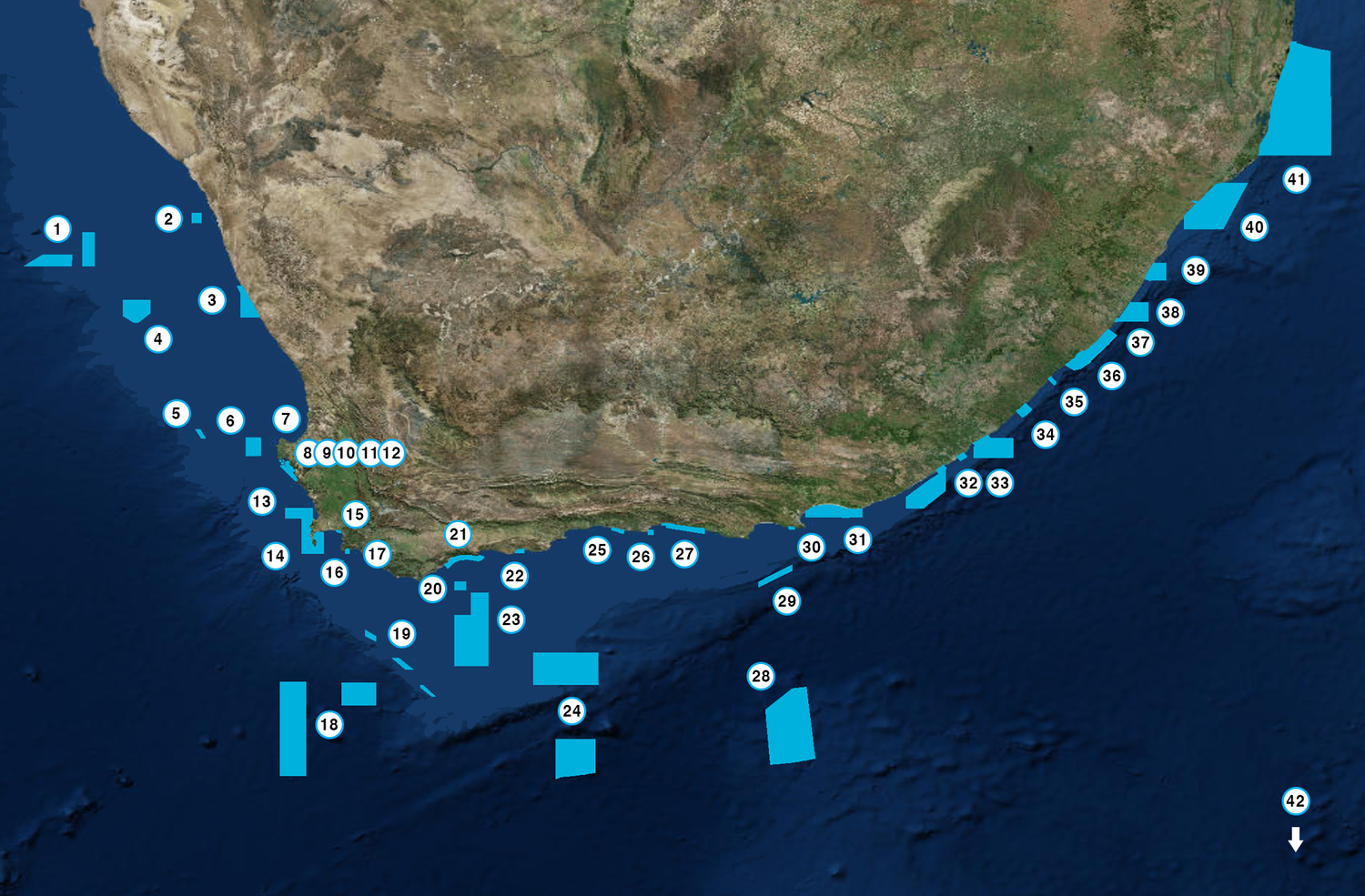LIFE PRESERVERS
Marine Protected Areas are our insurance policy for a climate-uncertain future

‘We depend on the ocean, we depend on a healthy ecosystem. Now we need to manage how we interact with it,’ a marine specialist explains
“People always say to me, how do you balance the need for Marine Protected Areas against the balance for people?” said Professor Mandy Lombard, the South African Research Chair in Marine Spatial Planning at Nelson Mandela University during a talk at the second Plett Marine Science Symposium last month.
“We don’t want to balance ourselves with the users of the ocean. We depend on the ocean, we depend on a healthy ecosystem,” Lombard said, explaining that not only do we rely on resources from the ocean, but also that the ocean drives the global climate.
“Now we need to manage how we interact with it.”
What are Marine Protected Areas?
A Marine Protected Area – or MPA – is an area of coastline or ocean that is specifically protected for the benefit of people and nature, according to the South African Association for Marine Biological Research.
Dr Jean Harris, executive director of the WildOceans programme at the WildTrust and a Pew Fellow in Marine Conservation, explains MPAs as “areas in the ocean (including estuaries) that restrict human activity primarily for biodiversity conservation purposes, whilst delivering social, cultural and economic benefits”.
MPAs can be fully, highly, lightly or minimally protected – from no extractive or destructive activities allowed, to some extraction and impacts allowed. But people can typically still dive, walk, swim and do a wide range of non-consumptive and non-damaging activities in MPAs.
How much of our oceans are protected?
Technically, 14.5% of South African waters are considered to be under protection, but Steve Kirkman, specialist marine scientist for the Department of Forestry Fisheries and the Environment (DFFE), explained to Daily Maverick that most of that comprises the large Prince Edwards Islands MPA in South Africa’s Southern Ocean territory.
Read more in Daily Maverick: SA needs to preserve the equivalent of Kruger Park each year to meet UN goals
If you discount that, only 5.4% of South Africa’s continental marine waters are protected today, which is fairly new development.
The spatial protection of South Africa’s ocean environment used to be at just 0.4%, but in 2019, the DFFE declared 20 new offshore MPAs, bringing the total up to 42 MPAs (and 5.4% protection).
The new MPAs were “designed through a very systematic consultative methodology”, Lombard said. “And there was a political window of opportunity that came along, which allowed us to do this, but we were ready with the science.”

Forty-one of South Africa’s MPAs are dotted along the coastline. The 42nd is in the Southern Ocean
How do MPAs work?
Lombard explained that government organisations (such as Sanparks or CapeNature) employ compliance officers, who are deployed daily or weekly (depending on the budget), acting as a presence on the reserve to catch or apprehend anyone who breaks the law.
“But the efficacy of those compliance officers is anything from absolutely brilliant to absolutely useless,” Lombard said, explaining that after a change in management, some compliance officers don’t have boat licences, and that in the past five years conservation agencies’ budgets have been drastically cut, which affects the bottom of the food chain first (compliance officers).
The oldest MPA in Africa under threat
Tsitsikamma, established in 1964 and Africa’s oldest MPA, has historically been mostly a “no take” area – meaning no extractive activities were allowed at all.
“All the fish research done in Tsitsikamma has shown that the fish are bigger, more abundant and more diverse within the MPA, which are genuinely the three characteristics you find in an MPA,” Lombard said, adding that across the world studies have shown that fish inside MPAs are more abundant and are bigger (because the fish are longer lived and are allowed to get bigger), and there’s species diversity, because certain species haven’t been fished out and top predators are still present.
“When you fish down the food chain, as we call it, then you lose your top predators,” explained Lombard.
“In a system like Tsitsikamma which was a no take MPA, you would expect a lot of diversity and not a lot of dominance in any one species, and that is exactly what you find.”
But just 100km down the coast at the Goukamma MPA, blacktail (near the bottom of the food chain) is the dominant species, forming 57% of the species composition.
Goukamma is technically declared an MPA, but because fishing from the shore is allowed, “it’s not actually a marine protected area,” according to Lombard, who lives in that area. “What it is, is a node of exploitation.
“This shore-based fishing removes the predatory fish from those zones, causing the dominance of the blacktail species. This dominance is indicative of an ecosystem in decline, and is a trend also seen in the Mediterranean (a highly overexploited fishing area) – and something that should not be happening in an MPA,” she said
So when the government decided in 2016 to allow shore-angling along 20% of the coastline within Tsitsikamma, it met significant public and scientific opposition, because the same thing is likely to happen there.
‘Paper parks’
Lombard said we won’t get the benefits from MPAs (as in Goukamma) unless they are fully protected, but we also need proper management, research, monitoring – “and to have that, you have to have stable and accountable and honest governance”.
Although it was a win for the scientific community when 20 new MPAs were declared in 2019, they don’t all have management plans yet –meaning there is no way of checking compliance with their regulations, and many are too far offshore to be accessible for researchers
“So in terms of who’s going to go and catch the naughty guys, who’s going to do the research, who’s going to manage that area, and who’s going to pay for the boats … that has not been done,” Lombard said.
“They are what we call paper parks.”
“Paper parks” are areas that are technically declared as a conservation estate on paper, but are not being properly conserved on the ground (or in the water.)
Daily Maverick previously reported that a conservation assessment by the Endangered Wildlife Trust (EWT) cautioned that our existing (terrestrial) conservation estates cannot be allowed to become “paper parks” – on paper, there are more than 400 provincial parks in SA, but most of these are failing because of management issues, insufficient budget or lack of political will.
Read more in Daily Maverick: More money, better leadership, trained staff: How to prevent SA’s provincial wildlife gems from sliding into ruin
“The world loves to declare marine protected areas, so they can tick a box politically, but they’re not prepared to actually protect it fully, because they got negotiated down by fishing and oil and gas and recreational use,” Lombard said at the symposium.
MPAs are humans’ insurance for the future
“If you want to withstand climate change, and the things that we can’t control, the best way to prepare ourselves for environmental curveballs is to save places in good condition,” Lombard said, adding that MPAs are like saving money for a rainy day.
“There’s enough evidence now that shows that fully protected MPAs provide more resilience to unknown impacts of climate change.”
The ocean produces about 50% of the oxygen that we breathe and absorbs 30% of global carbon dioxide emissions.
“What that means is the ocean acts as a buffer for global warming. So as the planet gets hotter, the ocean soaks up a lot of that heat,” Lombard said, explaining that water has a very high specific heat capacity, meaning it takes a lot of heat to warm it up and absorb some of the heat caused by anthropogenic global heating [warming].
The Intergovernmental Panel on Climate Change’s (IPCC’s) Sixth Assessment, published in August 2021, found that, “it is indisputable that human activities are causing climate change. Human influence is making extreme climate events, including heatwaves, heavy rainfall and droughts, more frequent and severe.”
The ocean helps mitigate these climate change events, Lombard said, adding that “a lot of small island states have very vulnerable coastlines, where they experience storm surges, cyclones and tsunamis. And if they [these extreme climate events] have destroyed their coral reefs, their coastal dunes or their mangroves (which are the natural buffers) … [we can expect] human tragedy beyond what you can even imagine happening in those places, because they have reduced the level of the ecosystem services”.
Therefore, we need to ensure we have healthy and diverse ecosystems in our oceans because healthy ecosystems are more resilient to climate change.
Lombard said MPAs alone won’t save our seas – we need well-managed fisheries outside protected areas, and deal with other threats such as ocean noise and ship strikes
“But at the end of the day, we don’t know what the future holds. So let’s keep money in the bank. Let’s have an insurance policy. And our insurance policy is our MPAs.” DM





















 Become an Insider
Become an Insider
Hmm title is rather misleading .
Am all for the MPA s and promoting healthy ecosystems for various species to survive .
So by extension all fishing should be banned , to save the climate ?
What is the connection ?
The oceans have risen and fallen many metres over the years .
I live about 100 m above a river , 1 km from the sea , houses the other side are about a km away .
Back in the day that was the width of the river , I dig down 2m and hit beach sand .
Yes , the movement of the oceans is critical to our life here .
Warmer waters and more ice breaking away , cooling the oceans and raising the sea levels .
Did basic physics at school , that old ‘ Displacement Law ‘ .
Ship building took off some 4000 years ago +- .
Today ? 1000 s if not millions of huge tankers and freighters , cruise ships , navies , check out the marinas and harbours all full . Of displacement hulls .
Climate change got us here we would have been a dinosaur snack , asteriod hit , big winter .
For those with STML , Krakatoa , was not fun .
While an advocate for no pollution , plastic waste etc . That will not change the climate , China ramping up coal plants will not help . Look how things are there ! Tragic!
Will they stop ? No ! Not of their own free will .